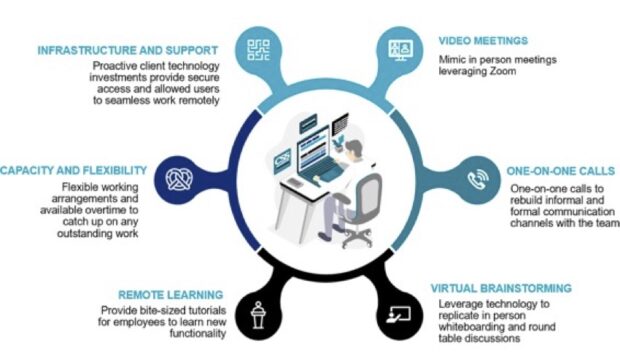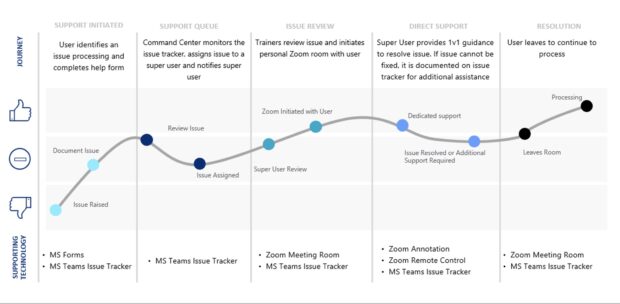For months, our team carefully monitored the project timeline to see if there would be enough time to roll out a multimillion-dollar digital transformation for a leading re-insurance organization with more than 3,200 professionals in over 60 offices around the world. With nearly a hundred team members working tirelessly over the past year to deliver, the group found ourselves abruptly halted on the tarmac, just as we were about to take off. People were looking around for answers, wondering what was going on. Would the project be grounded?
The uncertainty was driven by the COVID-19 pandemic. How could the team deliver a new global IT system to hundreds of users across multiple time zones who suddenly could not go into the office? This became the team’s “plane grounded; how do we take off?” moment. As the world faced an uncertain future, the project team scrambled to figure out how to deliver a new technology completely remotely. Bunkered in basements and shoved in spare bedrooms, the leadership team gathered to brainstorm options for getting this “plane” off the ground.
Before this setback, the team was midway through a four-year digital transformation journey with a global processing platform. After a previous successful rollout in Europe, the team was following a similar, roughly thousand-step playbook to deliver the global platform in North America, with the goal of future-proofing a leading financial services firm. At the end of the journey, this organization would digitize its global operating model to expedite transaction execution, reduce cost and enhance overall service delivery.
The approach taken at the last minute to execute a “pandemic-proof plan” leveraged new tools to support a remote digital transformation. This will become the norm for rolling out similar digitization strategies in the future. Business has forever been altered, and as companies push forward to transform, the winners will have embraced these new realities. The results during the pandemic have proven that organizations can lead successful implementations virtually.
Despite External Factors, the Project’s Rationale Still Held
The timing of the global pandemic could not have been worse. The deployment in North America was the company’s largest in terms of documents, users and clients—which provided the most expected benefits but also the highest risk.
The decision to move forward was difficult. Despite externalities, the original tenets of the project remained. Leadership agreed that stopping now would leave the company in a worse position than before, with yet another set of systems to manage and maintain globally. Everything was in place: The team was staffed up to deliver the work, and the external vendors were engaged. The team needed to assess if it could be successful with a remote digital launch, as well as how to support hundreds of users and thousands of customers making a remote switch to a new IT platform.
Work Remained the Same, But the Tools Changed
Now was not the time to stand still but to embrace change and adopt the fully remote working paradigm. A six-pronged approach was defined and rapidly deployed to enable the transformation while maintaining a “human touch” in a virtual environment.

Video Meetings: The organization encouraged video meetings using Zoom to maintain team culture and personal rapport while working remotely. This ensured that children, pets and background noises become part of the office psyche, allowing users the comfort to work freely.
Unplanned One-on-One Phone Calls: In an office setting, in-person hallway conversations help with information flow, build morale and assist with developing relationships. Due to COVID-19, this simple, underappreciated activity became a novelty. The team encouraged managers to place unscheduled calls to team members to check in on how they were doing. Team members appreciated this simple initiative and felt motivated to go above and beyond in challenging circumstances.
Virtual Brainstorming: Meetings were facilitated using live note-taking over Zoom or Teams. The team leveraged virtual collaboration tools such as Mural and Digital Sticky Notes to mimic in-person sticky note exercises and roundtable discussions.
Remote Learning: The halted takeoff made the team restructure the plan to train hundreds of users on a new platform. Traditional transformations have relied on in-person training with bounded reference materials to ensure that users were comfortable with the new processing platform prior to going live. In this case, however, the team switched gears midstream to create a library of hundreds of video tutorials with voice commentary. To keep users engaged, the videos were limited to five to seven minutes and focused on specific use cases. Users were encouraged to go through these videos at their leisure over a month-long period and could ask questions during dedicated sessions.
Additional Capacity and Flexibility: The pandemic upended the personal and professional lives of team members. There was no longer a boundary between the workplace and the home. To help team members cope with stress, the client allowed for flexible working hours one day a week and allocated funding to compensate employees for working overtime. These incentives improved employee satisfaction and facilitated the change journey.
Infrastructure and Support: Technology and infrastructure teams really stepped up, working overtime to ensure that existing networks and VPN tunnels were upgraded to allow seamless connectivity in a remote setting.
Remote Helpdesk—Leveraging Available Tools to Create a ‘Call Me Back’ Function
In addition to the above, to bolster the remote go-live it was also critical to develop a support system post-deployment for users working from home. Successful previous go-lives featured vendors and support staff on-site, walking the floor and troubleshooting with users. Duplicating this experience would be difficult remotely.

To provide a similar experience using a remote helpdesk process, the team created a “call me back” function using a simple workflow that pieced together available technologies. The team leveraged existing tools (Microsoft Forms, Microsoft Teams and Zoom) to log, track and remediate issues. First, a Microsoft Forms request link was shared with all users for them to submit issues as they arose. The Microsoft Form was linked to an Excel-based issue log on the back end, which captured the user’s email, a timestamp, description of the issue, system(s) affected and issue categorization type.
The command center team, like an air traffic control tower directing plane traffic, was set up, comprised of the best-trained users to support and manage the resolution process. When an issue was logged, it would appear in near-real time on the Microsoft Teams’ Excel dashboard, and the command center would assign trainers to reach out to the user via Zoom for issue resolution, in addition to identifying themes among issues. Using Zoom, the support staff could screen share and even take control of users’ screens to resolve issues. Attention to an issue was provided in minutes, which allowed the user journey sentiment to strengthen. If the issue was resolvable, remarks would be added to the Microsoft Teams’ Excel dashboard and closed. If the issue required vendor support, the trainer would invite the vendor, in real time, onto the Zoom session with the user to address the issue—providing high-touch support that paralleled a support team assisting users in an office environment.
While relatively simple in structure, the remote helpline offered a highly effective “call me back” capability that one might find in leading customer-centric companies such as Amazon or Google. This structure provided team members with essential support at key moments in the user journey. In total, over three thousand issues were raised and resolved by the relatively small but effective team over the course of a few weeks. Additionally, having all issues raised centrally allowed the team to quickly identify critical themes, the bulk of which were resolvable through additional user training. The company considered this approach a game-changer in a remote environment.
The Transformational Journey Must Continue
To everyone’s relief, airplane travel—flights—have resumed and will continue with more frequency. While they require more checks and cautions, as will tomorrow’s transformation efforts, they must continue.
Getting the green light to take off was a challenge during this digital transformation. The risks of a shaky takeoff and the ramifications of not getting it right nearly outweighed the benefits of the rollout. If the plane had not been able to get off the ground, the company would have been incapable of seamlessly serving its clients for hours, if not days on end, until the issues were corrected. The team pulled together a strategy that was highly effective, less expensive and laid the groundwork for rolling out the remaining deployments virtually. Despite the physical distance and separation of the team, it created an environment that brought team members closer and created stronger bonds and communication, which will only strengthen the ability to deliver the remaining portions of the digital transformation, whether in person or virtually.
This example of an organization forced to conduct a digital transformation remotely proves that the art of the possible is now the art of reality. Companies can now be confident that remote digitalization projects can experience similar success virtually while also reducing the financial investment—leading to a newly transformed normal in the post-COVID-19 era.





















 How Insurers Can Avoid Post-Merger Technology Failure
How Insurers Can Avoid Post-Merger Technology Failure  Insurance Costs, Climate Concerns Factor Heavily in U.S. Home Buying Decisions
Insurance Costs, Climate Concerns Factor Heavily in U.S. Home Buying Decisions  Slideshow: Carrier Management’s 2025 Top Editor’s Picks (Unlocked)
Slideshow: Carrier Management’s 2025 Top Editor’s Picks (Unlocked)  Breaking: Andersen to Replace Zaffino as CEO of AIG on June 1
Breaking: Andersen to Replace Zaffino as CEO of AIG on June 1 








